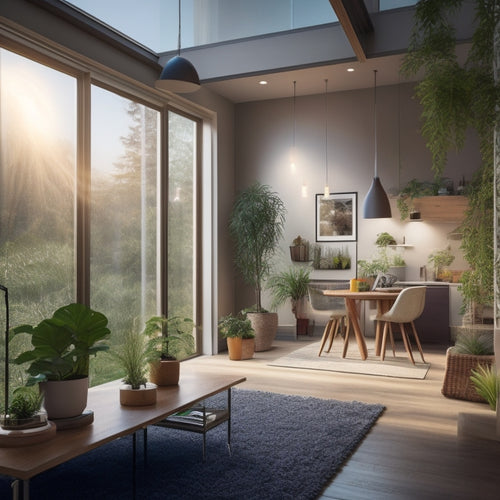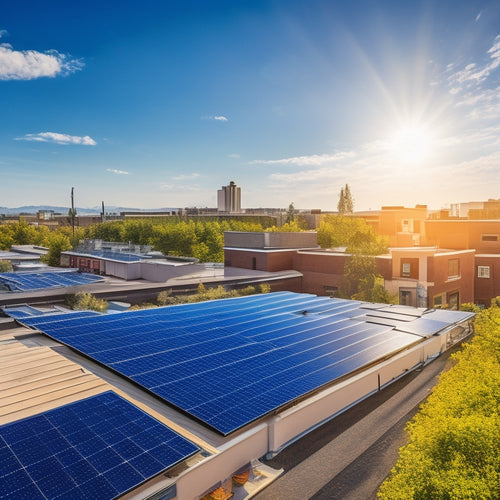
What Is the Right Solar Panel System for You?
Share
You need a solar panel system tailored to your unique energy needs, roof layout, and local building codes. Start by analyzing your daily energy consumption and conducting an energy audit to identify areas for optimization. Assess your roof's solar potential, considering size, orientation, and shading. Choose solar panels that meet your energy needs, and select an inverter with a matching capacity. Don't forget to calculate your battery backup needs and guarantee compliance with local building codes. By doing so, you'll be well on your way to maximizing your return on investment - and there's more to explore to make sure your system operates at peak performance.
Key Takeaways
• Determine your daily energy consumption in Wh to choose a system meeting your specific energy needs.
• Assess your roof's size, orientation, and shading patterns to ensure optimal solar panel placement.
• Select solar panels based on efficiency, type, and features that fit your budget and energy requirements.
• Calculate your inverter and battery backup needs to ensure a reliable and efficient system.
• Consider real-time monitoring and optimization to maximize your system's energy output and ROI.
Understanding Your Energy Needs
To determine the right solar panel system for your property, you need to accurately assess your energy requirements, which involves calculating your total daily energy consumption in watt-hours (Wh). This calculation is essential in determining the size of the solar panel system you'll need to power your home.
Conducting an energy audit is a great way to get an accurate estimate of your energy needs. An energy audit involves analyzing your past energy bills to identify patterns and trends in your energy usage. By reviewing your historical consumption, you can identify areas where you can reduce your energy consumption and optimize your energy usage. This data will help you determine the right size of the solar panel system that can meet your energy needs.
A thorough energy audit will provide you with a clear understanding of your energy requirements, enabling you to make informed decisions when selecting a solar panel system. With this information, you'll be able to choose a system that meets your specific energy needs, ensuring you maximize your energy savings and reduce your carbon footprint.
Assessing Your Roof's Solar Potential
When evaluating your roof's solar potential, you'll need to analyze several key factors.
You'll want to examine the size and orientation of your roof, as well as any shading or obstructions that might impact energy production.
Additionally, you'll need to research local building codes and regulations that may affect your solar panel installation.
Roof Size and Orientation
Your roof's size and orientation play a significant role in determining its solar potential, as they directly impact the amount of sunlight that can be harnessed. A larger roof size means more space for solar panels, but it's not just about size - the orientation of your roof also matters.
Here are three key factors to take into account:
-
Roof Angle: A roof with a pitch between 15° and 40° is ideal for solar panels, as it allows for efficient energy production and easy snow shedding.
-
Architectural Style: Certain architectural styles, such as modern or contemporary designs, may be more conducive to solar panels due to their simpler rooflines and fewer obstructions.
-
Directional Orientation: A south-facing roof receives the most sunlight, making it the preferred orientation for solar panels. East- and west-facing roofs can also work well, but north-facing roofs may not be suitable.
Shading and Obstructions
As you evaluate your roof's solar potential, analyzing shading and obstructions becomes a crucial step in determining the effectiveness of a solar panel system. Shading from trees, buildings, or other structures can greatly reduce the energy output of your solar panels.
You'll need to assess the shading patterns on your roof to identify areas that receive direct sunlight for the most hours during the day. Tree overhangs, in particular, can cast substantial shadows on your roof, especially if they're tall or have dense foliage.
You may need to trim or remove trees to minimize shading. Additionally, building protrusions like vents, skylights, or chimneys can also cast shadows or obstruct sunlight.
You'll need to take these obstructions into account when designing your solar panel system to maximize energy production.
Local Building Codes
Prior to installing a solar panel system, you must verify that it complies with local building codes and regulations that govern the installation, inspection, and maintenance of solar panels in your area. This is essential to make sure the system meets the necessary safety standards and to avoid any potential penalties or fines.
To guarantee code compliance, you'll need to:
-
Review local permitting requirements: Familiarize yourself with the permitting process and requirements in your area, including any necessary inspections and approvals.
-
Check with local authorities: Verify that your solar panel system meets local building codes and regulations, including any specific requirements for roof-mounted systems.
-
Obtain necessary permits: Secure all necessary permits and approvals before installing your solar panel system to avoid any legal issues.
Choosing the Right Solar Panels
When choosing the right solar panels for your system, you'll want to take into account the panel efficiency ratings, which measure how well a panel converts sunlight into electricity.
You'll also need to decide between different types of solar panels, each with their own strengths and weaknesses.
Panel Efficiency Ratings
You'll want to scrutinize the panel efficiency ratings of different solar panels to make sure you're getting the most energy output per unit area. A higher efficiency rating means more power per square foot, making the most of your available roof space.
When evaluating panel efficiency, consider the following key factors:
-
Cell Temperature: Higher temperatures can reduce efficiency, so look for panels with built-in temperature control mechanisms.
-
Efficiency Metrics: Pay attention to the panel's efficiency rating under standard test conditions (STC) and its performance in real-world scenarios (PTC).
-
Maximum Power Point (MPP) Tracking: Make sure the panel's MPP tracking system optimizes energy output by identifying the point at which the panel produces maximum power.
Types of Solar Panels
Typically, homeowners and businesses choose from three main types of solar panels, each with its unique characteristics, advantages, and disadvantages. You'll want to understand these differences to select the best fit for your solar panel system.
The most common type is Monocrystalline Silicon (mono-Si) panels, known for their high efficiency ratings and durability. They're a popular choice, but also the most expensive option.
Polycrystalline Silicon (poly-Si) panels are another option, offering a lower price point and similar efficiency ratings to mono-Si panels.
Thin Film solar panels are the third type, made with a thin layer of photovoltaic material. They're more flexible and less expensive, but their efficiency ratings are lower.
Some solar panels incorporate Bifacial Cells, which can absorb light from both the front and back sides, increasing energy output.
When selecting a solar panel type, consider factors like budget, energy needs, and roof space to make an informed decision. By weighing the pros and cons of each type, you'll be able to choose the right solar panels for your specific situation.
Selecting the Ideal Inverter Size
Selecting the right inverter size for your solar panel system is crucial to guarantee maximum energy harvesting and efficiency, as an undersized inverter can lead to energy losses and reduced system performance. You need to make sure that your inverter can handle the power output of your solar panels.
To determine the ideal inverter size, consider the following factors:
-
Inverter capacity: Choose an inverter with a capacity that matches your solar panel array's maximum power output. This ensures that your system can handle peak power production.
-
Power optimization: Consider the inverter's ability to optimize power production. Look for inverters with features like maximum power point tracking (MPPT) to ensure maximum energy harvesting.
-
System configuration: Consider the number of strings and panels in your system. This will help you determine the required inverter capacity and configuration.
Calculating Battery Backup Needs
To guarantee a reliable and efficient solar panel system, determine your battery backup needs by calculating the total watt-hours required to power your critical loads during an outage. This calculation is essential to make sure your system can provide backup power when you need it most.
Start by identifying your critical loads, such as refrigeration, lighting, and communication devices. Next, calculate the total wattage of each load and multiply it by the number of hours you expect to use it during an outage. This will give you the total watt-hours required.
For example, if you have a 100W refrigerator that needs to run for 8 hours, you'll need 800Wh of backup power.
Accurate load calculation is vital for proper battery sizing. Underestimating your backup needs can leave you without power when you need it, while overestimating can lead to unnecessary costs. By calculating your battery backup needs, you can make certain your system is designed to meet your specific requirements.
Considering Local Building Codes
You must consider local building codes and regulations when designing your solar panel system to guarantee compliance and avoid costly revisions. Failure to comply with local codes can result in fines, penalties, or even system removal. As you design your solar panel system, it's crucial to research and understand the specific regulations in your area.
Here are three key considerations for code compliance:
-
Permit requirements: Determine what permits are necessary for your solar panel installation, and factor in the time and cost of obtaining them.
-
Code compliance: Make sure that your system meets local building codes, including electrical and fire safety standards.
-
Inspection and certification: Schedule necessary inspections and obtain certification from local authorities to confirm your system meets code requirements.
Optimizing System Performance Online
By leveraging online monitoring platforms, your solar panel system's performance can be tracked in real-time, enabling swift identification of potential issues and optimization of energy production. This real-time tracking allows you to stay on top of your system's performance, ensuring you're getting the most out of your investment.
| Feature | Benefit |
|---|---|
| Real-time monitoring | Identify issues quickly and take corrective action |
| Energy production tracking | Optimize energy output and reduce waste |
| Performance analytics | Gain insights into your system's strengths and weaknesses |
| Alert systems | Receive notifications of potential issues before they escalate |
With online system monitoring, you can analyze your system's performance remotely, identifying areas for improvement and making data-driven decisions to optimize energy production. This level of visibility enables you to proactively address potential issues, reducing downtime and ensuring your system operates at peak efficiency. By staying connected to your system's performance, you can maximize your return on investment and enjoy the full benefits of solar energy.
Frequently Asked Questions
Can I Install Solar Panels on a Metal or Clay Tile Roof?
You'll need to assess your metal or clay tile roof's condition before installing solar panels; consider roof preparation, including tile removal, to guarantee a secure and watertight installation, and consult a professional if you're unsure.
How Long Does a Typical Solar Panel System Last?
You're likely wondering how long your investment will last; think of a solar panel system like a trustworthy car - with proper maintenance, it'll drive smoothly for 25-30 years, guaranteeing a long system lifespan and exceptional solar panel durability.
Will Solar Panels Work During a Power Outage?
When the grid goes down, you'll need a system designed for grid independence, incorporating an emergency backup, to guarantee your solar panels continue generating power during a power outage, keeping your lights on and critical appliances running.
Can I Expand My Solar Panel System in the Future?
Like a master builder adding wings to a castle, you can expand your solar panel system in the future through System Upgrades, ensuring your investment grows with your needs, thanks to forward-thinking Future Planning.
Do Solar Panels Require Regular Maintenance or Cleaning?
You'll be relieved to know that solar panels require minimal maintenance; however, you should occasionally clean them to mitigate dust accumulation, as it can reduce efficiency - luckily, rainwater can help with this, making maintenance a breeze.
Related Posts
-

Energy-Efficient Lighting Solutions for Sustainable Buildings
For sustainable buildings, energy-efficient lighting solutions, like LEDs, offer multiple benefits. These bulbs last ...
-

Energy-Efficient Home Upgrades for Cost Reduction
To reduce costs with energy-efficient home upgrades, focus on essential improvements like smart thermostats, energy-e...
-

Solar Energy Solutions for Small Businesses
Switching to solar energy can be a game changer for your small business. You'll enjoy significant cost savings on mon...


